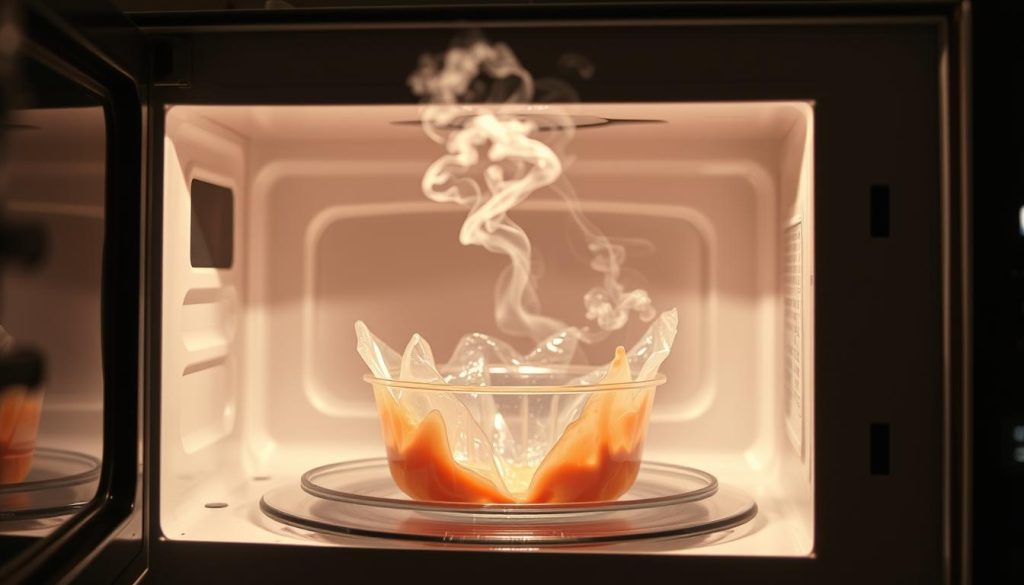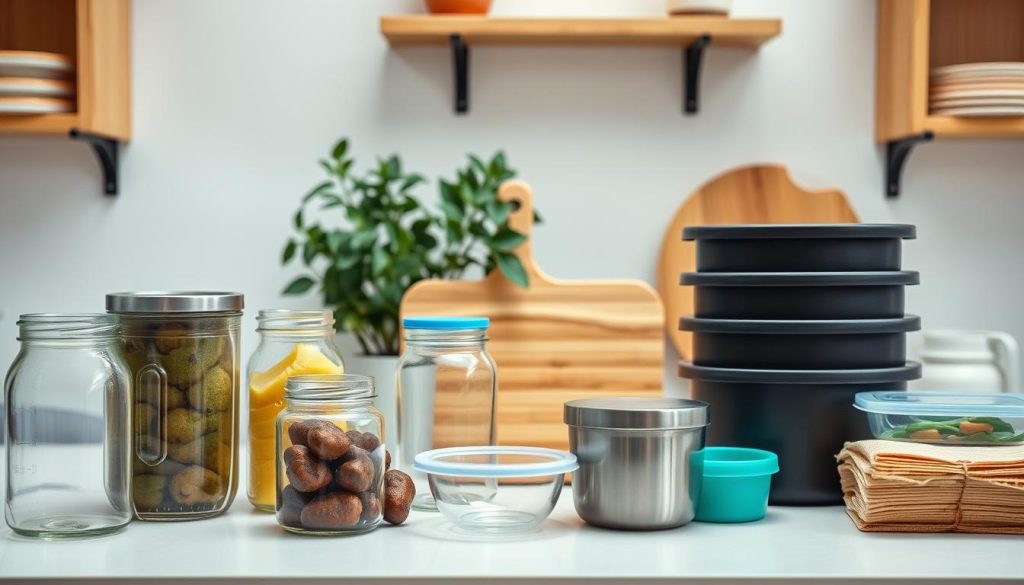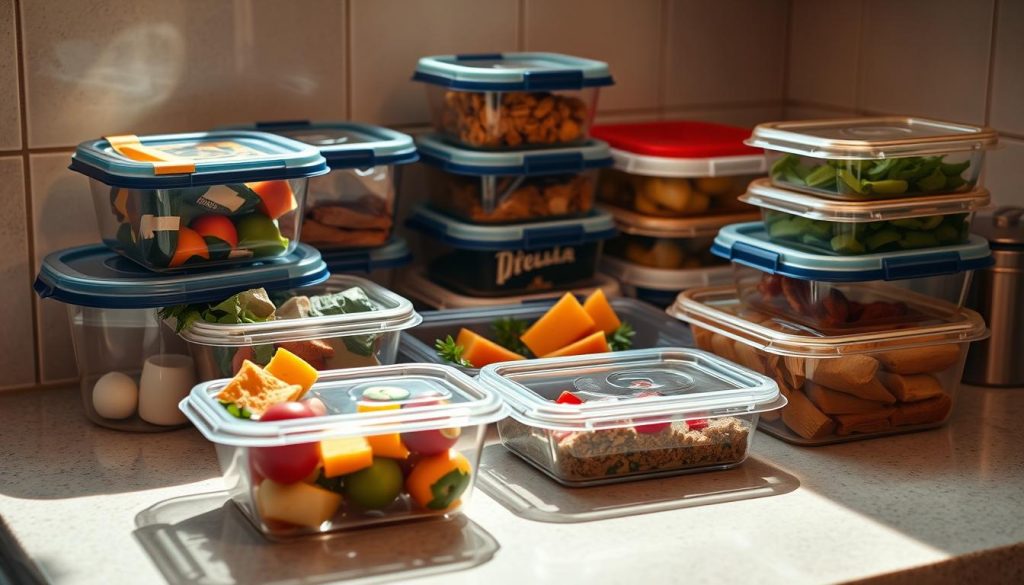Many of us wonder if it’s okay to microwave food in plastic containers is it safe. It’s important to know about microwaving food safety to make sure our meals are safe. This section will talk about the risks of using plastic containers in the microwave. We’ll also share tips from health groups on how to safely reheat food.
Key Takeaways
- Microwaving food in plastic containers can be convenient but requires caution.
- Understanding the types of plastics and their safety levels is key for microwaving food safety.
- Health organizations give guidelines to keep food safe in plastic containers.
- Following the right microwaving practices can lower the risks of heating food in plastic.
- Using glass or ceramic containers can be safer for reheating food.
Understanding Microwave Safe Plastic Containers
When reheating food, it’s key to know the right plastic to use. Using microwave safe plastic containers keeps your food safe from harmful chemicals.
What is Microwave Safe Plastic?
Microwave safe plastic can handle high temperatures without breaking down. It’s made to be free from BPA and other harmful chemicals. Plastics like polypropylene (PP) and certain polyethylene types are used for safe reheating.
Identification of Microwave Safe Symbols
It’s easy to tell if your plastic is microwave safe. Look for symbols or labels on microwave safe plastic products. You’ll see wavy lines or a microwave icon. Also, following plastic container microwave guidelines from the maker ensures safe use.
Common Types of Plastic and Their Safety Levels
Knowing which plastics are safe for microwaving is key for your food’s quality and health. Here’s a look at the most common plastics in food containers and their microwave safety levels.
Polypropylene (PP)
Polypropylene, or PP, is a microwave safe plastic. It has a high melting point, which means it’s less likely to melt or break down in the microwave. Many containers made from PP are labeled as “microwave safe.” But, always check for this label to be sure.
Polyethylene Terephthalate (PET)
Polyethylene terephthalate, or PET, is used in many food containers. While PET is okay for cold storage and some reheating, it’s not good for microwave heating. It can release harmful chemicals when heated too high. So, it’s best to avoid using PET containers in the microwave.
High-Density Polyethylene (HDPE)
High-Density Polyethylene (HDPE) is strong and used in many food packages. But, not all HDPE containers are microwave safe plastic. Always check the usage instructions and labels to see if an HDPE container is safe for the microwave.
By knowing about these plastics, you can choose the right containers for microwaving. This helps keep your food quality and health safe.
Effects of Microwaving Non-Microwave Safe Plastic
Imagine you’re about to reheat leftovers and grab a plastic container. Before you start, it’s key to know the risks of microwaving non-safe plastic. The main worry is chemical leaching. High heat can make harmful chemicals in the plastic leak into your food.
Another risk is that the plastic might break down. This could cause it to warp or even melt. Such damage can lead to burns and spills, ruining your meal and making a mess in your microwave. Always check labels and choose microwave safe plastic to keep your food and kitchenware safe.
Microwave Safety Tips for Using Plastic Containers
Using plastic containers in the microwave can be safe if you follow some guidelines. These tips help avoid dangers like chemicals leaking or containers breaking. Here are some important tips to keep in mind:
Always Check Labels
Before microwaving food in plastic, always check the labels. Look for microwave-safe symbols or guidelines from the manufacturer. This is key to using the right container safely.
Avoid Microwaving Disposable Plastics
It’s best to not use disposable plastics in the microwave. They’re not made for high heat and can melt or leak harmful chemicals. Use reusable containers that are safe for the microwave.
Use Ventilation for Sealed Containers
When microwaving sealed plastic containers, make sure they have ventilation. This prevents steam buildup that could cause the container to burst. Always follow the manufacturer’s instructions for safe use.
Is It Safe to Microwave Food in Plastic Containers?
When thinking about is it safe to microwave food in plastic containers, it’s key to know the difference. Some plastics are safe for microwaves, while others are not. Non-microwave safe plastics can melt or leak chemicals into your food, which is bad for your health.
Health groups like the FDA say only use containers marked as microwave safe. These have been tested to handle microwave heat without harming you. Look for the resin identification code or microwave safe symbol on the container.
According to a study from the Harvard T.H. Chan School of Public Health, using microwave safe plastic containers significantly reduces the risk of chemical leaching during food reheating.
To stay safe, follow these microwave safety tips for plastic. Always pick containers that say they’re microwave safe. Don’t use disposable plastics. Also, make sure sealed containers have air to prevent pressure and uneven heating.
Here’s a comparison to help you decide is it safe to microwave food in plastic containers:
| Plastic Type | Microwave Safe | Common Uses |
|---|---|---|
| Polypropylene (PP) | Yes | Food containers, yogurt tubs |
| Polyethylene Terephthalate (PET) | No | Water bottles, food jars |
| High-Density Polyethylene (HDPE) | Yes | Milk jugs, detergent bottles |
Knowing and following these tips will keep your food safe and tasty when using microwave safe plastic containers. Stay informed and careful to safely use plastics in your microwave.
Risks of Microwaving Food in Plastic Containers

Using plastic containers in the microwave can be risky. It’s important to know these risks to keep food safe and ensure plastic container microwave safety.
Potential Chemical Leaching
One big worry is chemical leaching from plastic containers in the microwave. Some plastics, not marked as microwave safe, can leak harmful chemicals into your food. These chemicals, like Bisphenol A (BPA) and phthalates, can harm your health.
Studies by the National Institutes of Health (NIH) show that microwaving food in some plastic containers can release these harmful chemicals. This poses a health risk.
Impact on Food Quality
Microwaving food in plastic can also change its quality. The microwave’s heat can make plastics warp or melt. This can ruin the taste and texture of your meal. It’s key to use containers made for microwave use to avoid this.
In short, knowing the microwaving plastic risks and how they affect food quality is vital. It helps keep plastic container microwave safety and ensures food safety in microwaving.
Guidelines for Microwave Safe Plastic Use
Using plastic containers in the microwave requires following certain plastic container microwave guidelines. These rules are important for your safety and the life of your containers. They guide you on how to use microwave safe plastic correctly.
First and foremost, always check the labels on your plastic containers. Make sure they are marked as microwave safe. These symbols on the bottom of the containers mean the plastic can handle microwave heat safely.
Another key microwave plastic container precaution is to not microwave disposable plastics. Items like takeaway containers or single-use plastic wraps are not safe for the microwave. They might melt or release harmful chemicals into your food.
Also, be careful with how long you microwave your food. Even microwave safe plastics can get damaged by too much heat. It’s best to use them for short heating times and avoid long cooking sessions.
To keep your containers in good shape, make sure they are well-ventilated when microwaving. This helps prevent pressure build-up and keeps the container from deforming. Just lift the lid a bit or use a vented cover.
For a quick reference, here’s a table with important plastic container microwave guidelines:
| Guideline | Description |
|---|---|
| Check for Microwave Safe Label | Ensure containers are marked microwave safe to avoid harmful chemical release. |
| Avoid Disposable Plastics | Do not use single-use plastics in the microwave as they may melt or leach chemicals into food. |
| Limit Heating Time | Use plastic containers for short heating intervals to prevent damage. |
| Ensure Ventilation | Lift the lid slightly or use vented covers to avoid pressure build-up. |
By following these microwave plastic container precautions, you can safely and efficiently use your containers. This minimizes risks related to microwave safe plastic use.
Alternatives to Plastic Containers in the Microwave

Are you worried about using plastic containers in the microwave? There are safer options available. Try using *glass containers microwave safe* or *ceramic containers microwave use*. They make your kitchen safer and more efficient.
Glass Containers
*Glass containers microwave safe* are gaining popularity. They’re safe and durable. They don’t release harmful chemicals into your food.
Brands like Pyrex and Anchor Hocking offer a wide range. Their glass containers are perfect for the fridge and microwave. They won’t break easily.
Ceramic Containers
*Ceramic containers microwave use* are great alternatives to plastic. They’re safe and come in stylish designs. You can use them as both cooking and serving dishes.
Companies like Corelle and Le Creuset make high-quality, microwave-safe ceramics. They’re durable and safe for frequent use.
Choosing these alternatives makes your kitchen safer and more elegant. It adds functionality to your cooking experience.
Debunking Myths About Microwaving Plastic
Many myths about microwaving plastic cause unnecessary worry. One common myth is that microwaving food in plastic containers is dangerous. Critics say it releases toxic chemicals into food. But this isn’t entirely true.
Not all plastics are the same. Some are made for microwave use and are safe for food. Using microwave-safe plastics can keep your food safe while microwaving. The problem often comes from not knowing what’s safe.
Let’s look at some myths about microwaving plastic and clear them up:
- Myth: All plastics release harmful chemicals when microwaved.
- Fact: Only non-microwave-safe plastics are risky. Containers marked “microwave-safe” have passed safety tests.
- Myth: Microwaving plastic always damages its integrity.
- Fact: Microwave-safe plastics are made to handle heat without losing their shape or safety.
- Myth: Plastic containers and plastic wraps are equally unsafe.
- Fact: They’re not the same. Most microwave-safe plastics are okay for heating food, but some plastic wraps aren’t.
These myths can lead to wrong ideas about plastic container safety. The important thing is to use the right plastic.
| Myth | Fact |
|---|---|
| All plastics release harmful chemicals when microwaved. | Only non-microwave-safe plastics are risky. “Microwave-safe” plastics are tested rigorously for safety. |
| Microwaving plastic always damages its integrity. | Microwave-safe plastics are designed to withstand heat without compromising food safety. |
| Plastic containers and plastic wraps are equally unsafe. | Microwave-safe plastics are safe for food heating, unlike certain plastic wraps. |
Understanding the science behind microwaving food safety can help you use microwave-safe plastic containers safely.
Conclusion
So, is it safe to microwave food in plastic containers? You now know the answer is not simple. We’ve looked at what makes plastic safe for microwaving, the risks, and safety tips. It’s key to know which plastics are okay for the microwave to keep your kitchen safe.
When you’re microwaving, always check the plastic’s label and follow the guidelines. This helps avoid harmful chemicals and keeps your food fresh. Using microwave-safe plastics, like those labeled as BPA-free, is safer than disposable ones.
If you’re unsure, think about using glass or ceramic instead. These are safer and just as convenient. Remember, making smart choices about your microwave use is important. With this knowledge, you can safely and healthily cook in your kitchen.








2 thoughts on “Microwave Food in Plastic Containers Is It Safe ?”
https://shorturl.fm/7Teu1
https://shorturl.fm/VipGa